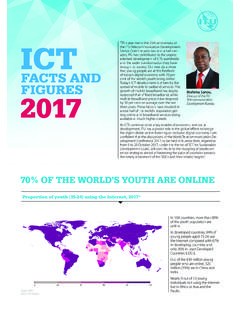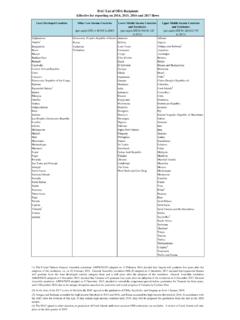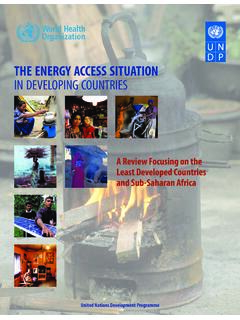Transcription of The Role of Agriculture in the Development of LDCs
1 THE ROLE OF Agriculture IN THE. Development OF LEAST-DEVELOPED. COUNTRIES AND THEIR INTEGRATION. INTO THE WORLD ECONOMY. Commodities and Trade Division Food and Agriculture Organization of the United Nations Rome, 2002. The designations employed and the presentation of material in this publication do not imply the expression of any opinion whatsoever on the part of the Food and Agriculture Organization of the United Nations concerning the legal status of any country, territory, city or area or of its authorities, or concerning the delimitation of its frontiers or boundaries. All rights reserved. Reproduction and dissemination of material in this information product for educational or other non-commercial purposes are authorized without any prior written permission from the copyright holders provided the source is fully acknowledged. Reproduction of material in this information product for resale or other commercial purposes is prohibited without written permission of the copyright holders.
2 Applications for such permission, should be addressed to the Chief, Publishing and Multimedia Service, Information Division, FAO, Viale delle Terme di Caracalla, 00100 Rome, Italy or by e-mail to FAO 2002. iii Contents PREFACE v THE ROLE OF Agriculture IN THE Development . OF LEAST-DEVELOPED COUNTRIES AND THEIR. INTEGRATION INTO THE WORLD ECONOMY 1. EXECUTIVE SUMMARY 3. INTRODUCTION 7. I. THE PRESENT SITUATION OF Agriculture 10. II. EXTERNAL ECONOMIC ENVIRONMENT: OPPORTUNITIES AND CHALLENGES 43. III. POLICIES TO FULLY EXPLOIT AND DEVELOP. THE AGRICULTURAL POTENTIAL 57. STATISTICAL ANNEX 73. ANNEX I. FAO TECHNICAL ASSISTANCE TO. Agriculture IN THE LEAST-DEVELOPED. COUNTRIES 97. INTRODUCTION 99. I. THE FAO FIELD PROGRAMME IN LDCs 100. II. SPECIAL DIMENSIONS 103. III. SOURCES OF FUNDING 106. IV. OUTLOOK 107. APPENDIX: FAO Field projects in operation in LDCs in 2000 109. ANNEX II. FAO COMPENDIUM OF KEY STATISTICAL. INDICATORS FOR LEAST- DEVELOPED COUNTRIES 125. iv v PREFACE. This volume contains contributions originally prepared by FAO for the Third United Nations Conference on the Least-developed Countries (LDCs) held in Brussels from 14 to 20 May 2001.
3 The material included here, which was presented to the thematic session on Enhancing Productive Capacities the Agricultural Sector and Food Security of the Conference, consists of an analysis of the role of Agriculture in the Development of least-developed countries and their integration into the world economy, a summary of FAO field programmes in LDCs and a compendium of agricultural statistical indicators relevant to the LDCs. These papers, which have been revised and edited, are being published in this form in order to facilitate a wider distribution. THE ROLE OF Agriculture IN THE. Development OF LEAST-DEVELOPED. COUNTRIES AND THEIR INTEGRATION. INTO THE WORLD ECONOMY. THE ROLE OF Agriculture IN THE Development OF LDCS 3. THE ROLE OF Agriculture IN THE Development . OF LEAST-DEVELOPED COUNTRIES AND THEIR. INTEGRATION INTO THE WORLD ECONOMY. EXECUTIVE SUMMARY. This paper examines the role of the agricultural sector in poverty alleviation and in the sustainable economic growth and Development of the least-developed countries (LDCs).
4 It sets out to provide up-to-date information and to generate debate that will help forge stronger consensus on actions needed for Agriculture to be accorded its rightful place in the LDCs. Agriculture is the mainstay of the LDC economies, underpinning their food security, export earnings and rural Development . Yet, their agricultural production for the domestic and export markets has lagged behind, with growth in per caput output declining in the 1990s. Slow production growth and sharp annual fluctuations in output have continued to be chronic problems for the LDCs, constituting the main causes of their persistent poverty and rising food insecurity. The proportion of undernourished in the total LDC population increased from 38 percent to 40 percent between 1969-71 and 1996-98, while the absolute number rose from 116 million to 235 million. As regards trade, the LDCs have continued to be marginalized in world agricultural markets, accounting for only 5 percent of global agricultural exports in the early 1970s and barely 1 percent in the late 1990s.
5 The poor performance of Agriculture in the LDCs is related to the many internal and external difficulties that these countries face as they seek to develop this sector and achieve their objectives of improving food security and increasing export earnings. Their internal difficulties include low productivity, rigid production and trade structures, a limited skills base, short life expectancy and low educational qualifications, poor infrastructure, and inadequate institutional and policy frameworks. 4 THE ROLE OF Agriculture IN THE Development OF LDCS. At the same time, with the growing integration of markets from globalization and trade liberalization, their economies have to operate in an increasingly competitive external environment. They continue to export a narrow range of primary commodities that are highly vulnerable to instability of demand and deteriorating terms of trade. In addition, external assistance to Agriculture in the LDCs has declined, with average annual ODA falling 20 percent from 1981-90 to 1991-99.
6 Their inability to compete not only on world markets but also on their home markets is reflected in their rising food import bills. Reversing this decline and integrating the LDCs into the world economy represent enormous challenges: overcoming marginalization from global markets; adapting to technological change; and coping with a new institutional environment. But most of the LDCs have enormous untapped agricultural potential to meet these challenges, with considerable scope for more effective use of resources and higher productivity. What is needed therefore is a renewed focus on agricultural and rural Development . Significant progress in promoting economic growth, reducing poverty and enhancing food security cannot be achieved in most of these countries without drawing more fully upon the potential productive capacity of Agriculture and its contribution to overall economic Development . With the support of their Development partners, the governments of the LDCs may need to rethink their agricultural and rural Development strategies if they are to achieve their social and economic objectives, including that of reducing the number of undernourished by 2015.
7 The paper highlights elements of a strategy for action by the LDCs - with the support of the international community - that will help them exploit their agricultural potential by strengthening their supply capabilities and competitiveness, and thus take full advantage of the trading opportunities inherent in the multilateral trading system. Progress is crucial on three fronts: raising and sustaining productivity and competitiveness; diversifying production and trade; and improving access to foreign markets. THE ROLE OF Agriculture IN THE Development OF LDCS 5. Recommendations for key actions to spur agricultural growth in the next decade are put forward for both LDC governments and their Development partners, drawing upon past experience and success stories, and taking into account emerging domestic and global challenges. The critical strategy must be to recapitalize Agriculture , investing more heavily in this sector and in programmes to develop rural economic and social infrastructure.
8 Public investment needs to be directed in particular towards promoting agricultural research and extension, improving access to financial services, providing investment incentives, and increasing access of the poor to support services and productive resources. The paper proposes the following priority measures: 1. The LDC governments must commit themselves to a coherent and comprehensive vision of agricultural and rural Development . They need to design, implement and constantly review a series of priority and carefully- timed measures necessary to boost investment in Agriculture : Maintaining sound and stable macroeconomic and trade policies that encourage investment in Agriculture ;. Strengthening human capital in rural areas through health and education services and access to productive resources;. Establishing a strong institutional environment that improves access to markets, ensures dissemination of information, sets standards and provides an adequate legal and regulatory framework.
9 Enabling research and extension services to develop productive and robust technologies under farm conditions;. Upgrading the marketing, transport and communication infrastructure to support farmers' access to seasonal and longer- term capital and inputs, and providing them with strong price incentives;. Safeguarding natural resource and environment capacity. 2. Such action on the part of the LDC governments can be rendered more effective if their Development partners take steps to: 6 THE ROLE OF Agriculture IN THE Development OF LDCS. Increase ODA and other forms of assistance to help the LDCs meet public investment needs in Agriculture . Current initiatives to provide financial assistance to LDCs through targeted debt relief and other means could be partly channelled towards supporting efforts to develop the sustainable agricultural potential of LDCs, in particular by strengthening research and Development and the extension services, by ensuring the availability of essential inputs and structured commodity finance, and by providing marketing assistance.
10 Support LDC efforts to facilitate the transfer of technology and the flow of foreign direct investment that will improve agricultural productivity and competitiveness;. Facilitate market access of LDC's agricultural commodities in developed and developing countries, notably by improving terms of trade, adapting multilateral trade rules to the institutional, human capital and infrastructural context of the LDCs, and assisting in developing product quality and pre- and post- production standards. THE ROLE OF Agriculture IN THE Development OF LDCS 7. INTRODUCTION. Role of Agriculture in the economy The agricultural sector is at the heart of the economies of the least-developed countries (LDCs). It accounts for a large share of gross domestic product (GDP) (ranging from 30 to 60 percent in about two thirds of them), employs a large proportion of the labour force (from 40. percent to as much as 90 percent in most cases), represents a major source of foreign exchange (from 25 percent to as much as 95 percent in three quarters of the countries), supplies the bulk of basic food and provides subsistence and other income to more than half of the LDCs' population.

















